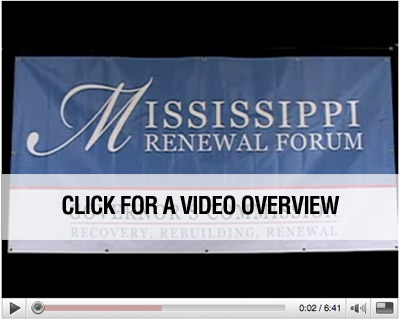

Welcome to this 2008, third-anniversary look back at paths to recovery and rebuilding in South Mississippi after Hurricane Katrina.
Thanks to support from the John S. and James L. Knight Foundation, the Congress for the New Urbanism, and the region’s Pulitzer Prize-winning SunHerald newspaper some of us who took part in the historic Mississippi Renewal Forum in October of 2005 were able to return to the Coast three years later to report on what happened – and what didn't – in the intervening years.
Here’s the bottom line: Every problem, and therefore every alternative solution, is more complex than we imagined.
It’s also clear that many of the challenges to recovery pre-dated the hurricane. For instance: A growing gap between household incomes and the costs of housing and insurance; infrastructure planning out of synch with growth; and political institutions pulled in opposite directions by the need to adapt to change and a determination to protect the status quo.
Sound familiar? By the Katrina Anniversary in 2008 it was becoming clear that another kind of storm, this one economic in nature, would force American communities beyond the Gulf Coast to come to terms with similar issues. So we stand by the observation we made in our first anniversary post:
“We think lessons learned and struggles still underway in South Mississippi can inform the conversation just heating up in America at large. In an important sense, Mississippi and Louisiana got to the future first. The hurricane blew them into the new era of increasing demands and diminishing resources.”

See for yourself if that idea is supported by the evidence. To get a feel for South Mississippi’s post-Katrina narrative, read through the updates posted immediately below. They’ll link to places on the site with more videos, slide shows, and documents.
To go directly to some of those documents and photos, peruse the list under “Dig Deeper” immediately to the left or click on “Anniverary Resources” in the toolbar above. For the complete record of the work produced during the 2005 Mississippi Renewal Forum, go to the toolbar and click on “Visit the Archived Renewal Forum Site.”

Of all the suggested paths explored by the Mississippi Renewal Forum, two have proved especially promising. And they offer models that can serve other communities across the country.
Katrina Cottages comprise a category of appealing, small-scale dwellings envisioned to serve the double purpose of replacing FEMA trailers with more livable emergency housing and of transitioning smoothly to neighborhood-friendly homes. Since the Forum, designs for Katrina Cottages – including multi-family and live-work versions – have multiplied. And Bruce Tolar, a Mississippi member of the Forum’s Architecture Team, has developed a model neighborhood of the cottages in Ocean Springs. You can see how Tolar’s Cottage Square was shaping up in 2008 in the post below.
The SmartCode is a regulating approach that enables communities to overcome the limitations of conventional zoning and plan future development in the spirit of Smart Growth designs like those produced during the 2005 Forum. While adoption of SmartCodes has not been as fast as many of its advocates wish, the fact remains that the Mississippi Gulf Coast probably represents the broadest region of the country where SmartCodes are in place or under consideration. You can follow the progress of coding efforts through August of 2008 by going here.

SEPTEMBER 4, 2008 – South Mississippi Coast. Deep into the 2008 hurricane season, with memories of the 2005 devastation from Hurricane Katrina firmly in mind, the Mississippi Gulf Coast struggles with a series of inter-connected issues hindering recovery. The primary link between those issues: housing.
According to the most recent Governor’s report on recovery, some 100,000 Mississippians were made homeless by Katrina, and, as of August 21, more than 4,300 families were still stuck in FEMA trailers with a March, 2009, move-out deadline approaching.
On August 28, the day before the third anniversary of Katrina, Mississippi Gov. Haley Barbour announced the appointment of former Biloxi Mayor Gerald Blessey as housing “czar” to oversee post-Katrina state and federal programs targeting housing needs. In the video below, recorded a day after his appointment, Blessey talks about the challenges and points to innovative approaches that may be gaining traction.

The programs Blessey refers to are outgrowths of the Katrina Cottage effort begun during the Mississippi Renewal Forum immediately after the storm in 2005. The MRF was funded in part by the John S. and James L. Knight Foundation, which also funded this website. For a review of the Forum’s work, go to this website’s archival pages here. And for background on the beginnings of the Katrina Cottage movement, go here.

The most recent developments under the broad category of Katrina Cottages have to do with the creation of an actual neighborhood of Katrina Cottages in Ocean Springs and with the adaptation of Katrina Cottage approaches through a Habitat for Humanity program in Diamondhead. Both were showcased during Hurricane Katrina third anniversary events along the Coast.
New to the Katrina Cottage discussion are Mississippi Cottages from the Mississippi Emergency Management Authority’s (MEMA’s) alternative housing initiative. That initiative was made possible by a $400 million federal grant to Gulf coastal states affected by Katrina. Mississippi got $281 million of that $400 million to create FEMA trailer replacements. The idea, stemming again from the 2005 Mississippi Renewal Forum, was to provide a storm-safe emergency dwelling that could make the transformation to neighborhood-worthy permanent housing.
MEMA’s FEMA trailer replacement goal has succeeded. The MEMA cottages, which come in 400-square-foot Park Models and larger two and three-bedroom Mississippi Cottage units, have been welcomed by Katrina victims trapped in FEMA trailers. But the transition to permanent housing in existing neighborhoods is still being tested. The problem: Local resistance to changing codes so that the smaller, factory-made cottages can find homes in Coastal neighborhoods.

What’s the hold-up? “Bureaucracy, insurance, home financing and weak local leadership that has allowed a Not-In-My-Backyard (NIMBY) mentality to drive critical decisions are among the primary obstacles to addressing the Mississippi Coast’s critical housing needs,” said a July report from a housing conference convened by the SunHerald editorial board. Housing advances are slowed by the reluctance of many communities to revise old zoning codes that would make Katrina Cottage-type dwellings legal in established neighborhoods and in new projects. For an overview by coding consultant Jeff Bounds, click here.
What both the Habitat project and Cottage Square hope to demonstrate is the viability of the MEMA cottages not only as safe, affordable units but also as fitting additions to just about any neighborhood. Click here to see Wendy McDonald, executive director of Habitat for Humanity Bay Waveland Area, walk us through the customizing of a MEMA Mississippi Cottage to meet the coding requirements of the Diamondhead neighborhood. And for more about the Habitat for Humanity effort in the area, go here.
By August 29, the third anniversary of Katrina, four of eight MEMA Park Models had been installed in Cottage Square. By November, the eight one-bedroom MEMA cottages are slated to be rented to Katrina victims and managed by the national non-profit Enterprise. To see an interview with Enterprise’s Michelle Whetten, who will work from an office in the original Katrina Cottage in Cottage Square, click here. Once the small cottages are occupied, Cottage Square becomes the first mixed-use Katrina Cottage neighborhood in the world.
A sense of real, supportive community is possible through well-designed clusters of cottages of this size. Architect Bruce Tolar and architect/designer Andres Duany talk about those possibilities for Cottage Square here. And Gayla Schmitt, Mercy Housing board member from Pass Christian, discusses her non-profit’s community-focused priorities here.
Similarly, “sense of community” has been a key topic in hard-hit East Biloxi since 2005. It’s a multi-ethnic neighborhood where many families in the broader region trace their roots. Yet it’s low-lying geography makes it vulnerable to flooding, and its low-income households can least afford the costs of building back in safer, elevated structures that meet new codes and FEMA guidelines. Mississippi State University’s College of Architecture, Art + Design has set up the Gulf Coast Community Design Studio to provide design assistance, volunteer coordination, and funding networks to support East Biloxi neighborhood recovery on a house-by-house, block-by-block basis. This effort, too, suggests approaches that could be worth replicating elsewhere. For a video interview with Design Studio director David Perkes, click here. And for more background on the initiative, visit the Design Studio here.

September 1, 2008 – Mississippi and Louisiana were barely into discussions surrounding the third anniversary of Hurricane Katrina when its citizens found themselves preparing for the assault of another potentially devastating hurricane. At this writing, Hurricane Gustav’s path, reaching landfall west of New Orleans on Monday afternoon, seems to have spared the eastern communities of South Mississippi. Louisiana parishes beyond New Orleans have not been as fortunate. What’s more, two named storms and at least one more tropical disturbance seem poised to threaten the US over the next week or so.
The big question on everyone’s lips: Have we learned enough since Katrina to minimize the loss of life and property?
The federal government has invested some $126 billion in the effort to give a positive answer to that question. And national and regional non-profits have poured millions into programs intended to strengthen chances for recovery for South Mississippi communities. The James S. and James L. Knight Foundation, which provided grants for the creation and renewal of this website, has led national non-profits in funding in South Mississippi. Here’s how Adele Lyons, program director for the Knight Foundation in Biloxi and Gulfport, explained the Foundation’s role as Gustav threatened:

Preparations for Gustav overwhelmed the attentions of those who had planned to spend Katrina anniversary week explaining the recovery progress of Gulf Coast communities. Ironies abounded. Reconstruction of Highway 90, the Coast’s Beach Boulevard, was still underway days before officials closed it down because of the new threat. For an eve-of-the-storm video tour of the rebuilt highway through the casino district of Biloxi and across the new, six-lane bridge between Biloxi and Ocean Springs, go here.
In succeeding posts, as Gustav and the other storms focus questions about storm-zone land use and housing, we’ll survey projects in the works along the Mississippi Gulf Coast, letting folks who’ve worked in programs over the last three years speak for themselves.

SOUTH MISSISSIPPI, August 27, 2008 – Cynicism on the western end of the Katrina-ravaged Gulf Coast has steadily escalated. In a recent story in the New York Times, the reporter, in an otherwise straightforward piece on a New Orleans city housing scandal drops this phrase into his narrative: “The classic New Orleans blend of possible corruption and certain mismanagement has dominated headlines for days...”
On bad days you’ll hear grumblings of “certain mismanagement” in Mississippi, as well. Yet you’ll also get full-throated optimism, particularly from business and political leaders who point to evidence that life is getting back to some semblance of normal – or at least to a “new normal.”
Leland Speed, former head of the Mississippi Development authority and a prime mover of the 2005 effort that created the Governor’s Commission on Recovery, Rebuilding, and Renewal, occupies the middle ground, where optimism and realism co-exist:

There’s plenty of evidence to suggest patience is rewarded, if at a much slower pace than many would prefer.
Read the city-by-city report of progress in the SunHerald’s August 24 editions, and you sense the progress. Same with the Gulf Coast Business Council’s anniversary report. And our special update on community planning along the Coast by New Towns reporter/editor Jason Miller.
Yet there’s no avoiding the question asked outright by cable news analysts safe in studios hundreds of miles from the storm zone and implied by the grumblings on the Coast: Why is it taking so long?
To better understand the context of an answer to that question, take a look at the three slide shows to the left. In the first, the SunHerald’s photographers capture the dramatic, permanent change in the Coast’s landscape in photos of the same places, the same structures, before and after the storm. In the second slide show, architect Steve Mouzon chronicles the depressingly un-recovered neighborhoods in his images of nightfall along the Coast in early 2007.
Look also here [6.4mb .pdf] at the groundbreaking final report of the Governor’s Commission at the end of 2005. Katrina changed forever not only the physical landscape of the Coast but also the more complex interrelationships of citizens and governments, individuals and communities. In both the literal and figurative sense, the storm surge knocked out the foundations of most peoples’ lives. Many victims were already living at the margins.
Consider: In Mississippi’s Hancock and Harrison Counties, almost three quarters of the housing units were occupied by households living below the U.S. median income level. Over 90 percent of the homes in Harrison County (Biloxi and Gulfport) did not have flood insurance. The majority (62 percent) of housing units across the three coastal counties was built before 1980 and below the standards of modern building codes. (ref: page 68 in the Governor’s Commission report)
Now consider the challenge of replacing 65,000 destroyed homes in a post-Katrina era in which building codes, FEMA regulations, escalating insurance prices, and rising construction costs complicate the lives of even those earning above-average wages. Then, add to that dilemma a national economy staggered by crises in the housing and financial markets, tightening lending and freezing new development.
If something approaching a quick “return to normal” was expected, the expectation was naïve. Even the leader of the most idealistic of the teams that came to Mississippi to help in planning encourages a more realistic perspective.
“Anyone who suggested that change would be easier in the Gulf because Katrina ‘wiped the slate clean,’ got it backwards,” says former Milwaukee Mayor John Norquist, now president of the Congress for the New Urbanism. “Reform is hard everywhere and even harder in the Gulf right now, but the social and economic payoff of staying committed to real renewal couldn’t be more worth it.”
You can see a powerful hint of that future in the images from SunHerald photographers in the third of the three slide shows to the left. These are photos taken over the last two years for a new SunHerald magazine called beachblvd. Here are images of a South Mississippi built back “better than ever,” just as Governor Haley Barbour challenged planners and community leaders to think about in the days after Katrina. It’s a set of intentionally rosy pictures. But they’re of real people and real places nonetheless. If they don’t quite balance the starker realities of South Mississippi’s recent history, they at least hint at the future payoff Norquist suggests.

August 25, 2008 -- The headline in a June, 2006 article in the design magazine, Architectural Record, proposed this question: “Can New Orleans and the Gulf Coast Face the Hard Questions?”
It’s been the question of the day, almost every day, since August 29, 2005, when Hurricane Katrina roared ashore in Mississippi and flooded New Orleans and adjacent parishes in Louisiana. Three years beyond the disaster, the most costly in U.S. history, that core question is obscured by the more emotional, more often-asked one: Why is it taking so long to build back?

With the help of a grant from the John S. and James L. Knight Foundation and in partnership with the SunHerald newspaper and the Congress for the New Urbanism we hope to provide, if not answers, at least a broader context for addressing these questions as they apply to post-Katrina recovery along Mississippi’s Gulf Coast.
This site, first launched in October of 2005, five weeks after Hurricane Katrina, has been the archive for products and follow-up projects of the Mississippi Renewal Forum, the weeklong design charrette funded by the Knight Foundation and James L. Barksdale. You can read all about that process and what emerged from it by clicking here to enter the archival section of the site.
In this third-year anniversary week update, we want to use this space to present the latest reports on progress and challenges and to broaden the “hard choices” discussion. We think lessons learned and struggles still underway in South Mississippi can inform the conversation just heating up in America at large. In an important sense, Mississippi and Louisiana got to the future first. The hurricane blew them into the new era of increasing demands and diminishing resources.
Two things are obvious to most folks who live and work on the Gulf Coast now. The extent of the storm’s destruction during Katrina was vastly under-appreciated by those who live outside the region. And the potential for an accelerated recovery was vastly exaggerated.
The bottom line, says Brian Sanderson, head of the Gulf Coast Business Council, is “that there’s no silver bullet. There’s no one thing that will solve the interconnected problems of housing, insurance, and all of the rest of the issues we’re dealing with -- plus the effects of the downturn in the national economy.”
The Gulf Coast Business Council, in August of 2008, published a report on successes and shortfalls since the storm: “Mississippi Gulf Coast 3.0.” There’s plenty of good news: Population in the three coastal counties has come back to within 96 percent of pre-Katrina levels; unemployment has dropped below seven percent after a 20-percent rate right after the storm; casino revenues, which provide sales taxes and reflect employment in the region, are expected to exceed pre-2005 levels for the second consecutive year.
Yet there are worrying aspects of the recovery effort: Steep rises in depression and suicide since the storm; wide swaths of the coastal landscape abandoned, at least for the time being, by property owners and businesses; Highway 90 is still under re-construction; insurance and construction costs are pushing homes beyond the reach of many workers and potentially dampening employers’ expansion plans.
There have been inspired plans and painfully slow implementation. Much is due to an atmosphere of uncertainty about where it’s safe to build and how much it will cost for storm-hardened construction and insurance. Much of it is connected to slow-moving state and government processes.
“Would-be developers or contractors, which nowadays could be anyone from a veteran professional to a single parent just trying to rebuild a home on their own, are finding the rolls of red-tape too much,” says Donovan Scruggs, former city planner for Ocean Springs, Mississippi, and now a planning consult with a local architecture firm. “This, combined with the NIMBYism (the Not-in-my-Backyard syndrome), are going to make recovery a very long and stressful process.”
Asked about lessons learned since the hurricane, Adele Lyons, Knight Foundation program director in Biloxi and Gulfport, says, “What I’m glad I didn’t know then was how long this recovery was going to take. We heard it was going to be a 10-year process, but we are impatient.
“We’ve been flying this airplane while we’re building it, and that’s not the best way to do business. But the reality is, this is a multiyear process. The first year was all about clean-up and getting organized. The second year, projects began bubbling below the surface. In the third year, we’re beginning to see things come out of the ground.”
What that means in terms of long-range renewal for the Mississippi Coast, we’ll explore in this week’s reports and analyses.
|

